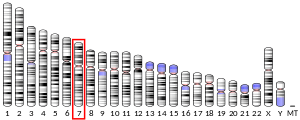Sp8 transcription factor
Transcription factor Sp8 also known as specificity protein 8 (SP-8) or Btd transcription factor (buttonhead)[5] is a protein that in humans is encoded by the SP8 gene.[6][7] Sp8 is a transcription factor in the Sp/KLF family.
Function
Sp8 mediates limb outgrowth during early development.[5] Sp8 deletion in mice resulted in severe exencephaly.[8] Sp8 is a zinc-finger transcription factor. The structural difference between Sp8 and Sp9 is only one amino acid. These transcription factors are Apical Ectodermal Ridge (AER) specific in limb development. The Apical Ectodermal Ridge signaling is important for specification of distal limb structures. Sp8 and Sp9 mediate Fgf10 signaling, which in turn regulates Fgf8 expression (Fgf10--->Fgf8). Fgf8 is essential for normal limb development, and without the presence of Fgf8 in early development, there would be a decreased length of the limb bud and possible failure of the limb tissue develop. Both Sp8 and Sp9 have been found in vertebrates. Although, so far only Sp8 has been proven to be present in invertebrates too. Under lab conditions, Sp8 replaced btd in Drosophila, showing that Sp8 and btd both have similar functions in limb development in both vertebrates and invertebrates. Gene knockdown in zebrafish displayed that Fgf8 expression is necessary for appendage development.[9]
References
- GRCh38: Ensembl release 89: ENSG00000164651 - Ensembl, May 2017
- GRCm38: Ensembl release 89: ENSMUSG00000048562 - Ensembl, May 2017
- "Human PubMed Reference:". National Center for Biotechnology Information, U.S. National Library of Medicine.
- "Mouse PubMed Reference:". National Center for Biotechnology Information, U.S. National Library of Medicine.
- Treichel D, Schöck F, Jäckle H, Gruss P, Mansouri A (November 2003). "mBtd is required to maintain signaling during murine limb development" (PDF). Genes & Development. 17 (21): 2630–5. doi:10.1101/gad.274103. PMC 280612. PMID 14597661.
- Bell SM, Schreiner CM, Waclaw RR, Campbell K, Potter SS, Scott WJ (October 2003). "Sp8 is crucial for limb outgrowth and neuropore closure". Proceedings of the National Academy of Sciences of the United States of America. 100 (21): 12195–200. doi:10.1073/pnas.2134310100. PMC 218735. PMID 14526104.
- "Entrez Gene: Sp8 transcription factor".
- Waclaw RR, Allen ZJ, Bell SM, Erdélyi F, Szabó G, Potter SS, Campbell K (February 2006). "The zinc finger transcription factor Sp8 regulates the generation and diversity of olfactory bulb interneurons". Neuron. 49 (4): 503–16. doi:10.1016/j.neuron.2006.01.018. PMID 16476661.
- Kawakami Y, Esteban CR, Matsui T, Rodríguez-León J, Kato S, Izpisúa Belmonte JC (October 2004). "Sp8 and Sp9, two closely related buttonhead-like transcription factors, regulate Fgf8 expression and limb outgrowth in vertebrate embryos". Development. 131 (19): 4763–74. doi:10.1242/dev.01331. PMID 15358670.
Further reading
- Lee MT, Chen CH, Lee CS, Chen CC, Chong MY, Ouyang WC, Chiu NY, Chuo LJ, Chen CY, Tan HK, Lane HY, Chang TJ, Lin CH, Jou SH, Hou YM, Feng J, Lai TJ, Tung CL, Chen TJ, Chang CJ, Lung FW, Chen CK, Shiah IS, Liu CY, Teng PR, Chen KH, Shen LJ, Cheng CS, Chang TP, Li CF, Chou CH, Chen CY, Wang KH, Fann CS, Wu JY, Chen YT, Cheng AT (May 2011). "Genome-wide association study of bipolar I disorder in the Han Chinese population". Molecular Psychiatry. 16 (5): 548–56. doi:10.1038/mp.2010.43. PMID 20386566.
- Milona MA, Gough JE, Edgar AJ (November 2004). "Genomic structure and cloning of two transcript isoforms of human Sp8". BMC Genomics. 5: 86. doi:10.1186/1471-2164-5-86. PMC 534095. PMID 15533246.
- Jugessur A, Shi M, Gjessing HK, Lie RT, Wilcox AJ, Weinberg CR, Christensen K, Boyles AL, Daack-Hirsch S, Nguyen TT, Christiansen L, Lidral AC, Murray JC (July 2010). "Maternal genes and facial clefts in offspring: a comprehensive search for genetic associations in two population-based cleft studies from Scandinavia". PLoS One. 5 (7): e11493. doi:10.1371/journal.pone.0011493. PMC 2901336. PMID 20634891.
- Barber MJ, Mangravite LM, Hyde CL, Chasman DI, Smith JD, McCarty CA, Li X, Wilke RA, Rieder MJ, Williams PT, Ridker PM, Chatterjee A, Rotter JI, Nickerson DA, Stephens M, Krauss RM (March 2010). "Genome-wide association of lipid-lowering response to statins in combined study populations". PLoS One. 5 (3): e9763. doi:10.1371/journal.pone.0009763. PMC 2842298. PMID 20339536.
- Kimura K, Wakamatsu A, Suzuki Y, Ota T, Nishikawa T, Yamashita R, Yamamoto J, Sekine M, Tsuritani K, Wakaguri H, Ishii S, Sugiyama T, Saito K, Isono Y, Irie R, Kushida N, Yoneyama T, Otsuka R, Kanda K, Yokoi T, Kondo H, Wagatsuma M, Murakawa K, Ishida S, Ishibashi T, Takahashi-Fujii A, Tanase T, Nagai K, Kikuchi H, Nakai K, Isogai T, Sugano S (January 2006). "Diversification of transcriptional modulation: large-scale identification and characterization of putative alternative promoters of human genes". Genome Research. 16 (1): 55–65. doi:10.1101/gr.4039406. PMC 1356129. PMID 16344560.
- Ravasi T, Suzuki H, Cannistraci CV, Katayama S, Bajic VB, Tan K, Akalin A, Schmeier S, Kanamori-Katayama M, Bertin N, Carninci P, Daub CO, Forrest AR, Gough J, Grimmond S, Han JH, Hashimoto T, Hide W, Hofmann O, Kamburov A, Kaur M, Kawaji H, Kubosaki A, Lassmann T, van Nimwegen E, MacPherson CR, Ogawa C, Radovanovic A, Schwartz A, Teasdale RD, Tegnér J, Lenhard B, Teichmann SA, Arakawa T, Ninomiya N, Murakami K, Tagami M, Fukuda S, Imamura K, Kai C, Ishihara R, Kitazume Y, Kawai J, Hume DA, Ideker T, Hayashizaki Y (March 2010). "An atlas of combinatorial transcriptional regulation in mouse and man". Cell. 140 (5): 744–52. doi:10.1016/j.cell.2010.01.044. PMC 2836267. PMID 20211142.



